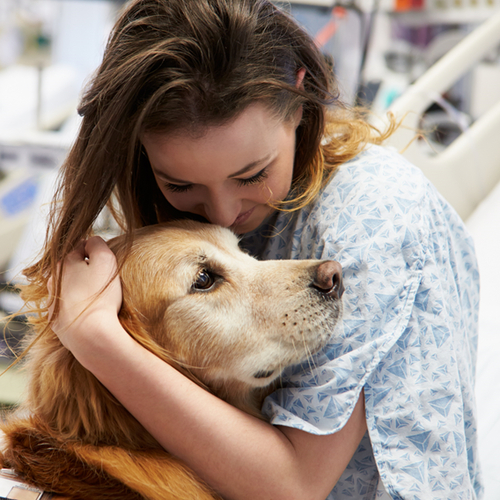
Animal-assisted therapy
Alternate names: Animal-Assisted Activities (AAA), Animal-Assisted Education, Animal-Assisted Intervention (AAI), Animal-Facilitated Therapy, Animal Companionship, Animals In Human Therapy, Animal Visitation, Canine-Assisted Ambulation, Canine-Assisted Therapy, Canine Therapy, Canine Visitation Therapy (CVT), Companion Animal Therapy, Dog-Assisted Therapy, Dolphin-Assisted Therapy, Equine-Assisted Activity, Equine-Assisted Activities and Therapies (EAAT), Equine-Assisted Therapy, Equine Therapy, Hippotherapy, Horse-Riding Therapy, Pet-Assisted Therapy, Pet-Facilitated Therapy, Pet Therapy, Psychoeducational Horseback Riding, Therapeutic Horseback Riding
Background
Animal-assisted therapy (AAT) involves using trained animals to help people cope with or recover from different health conditions.
AAT might help reduce stress and promote relaxation. It might also reduce feelings of loneliness. AAT that involves physical touch might stimulate pleasure in the brain. This seems to promote relaxation and well-being. AAT might also work by distracting patients from pain and activating comforting thoughts.
People use AAT for anxiety. It is also used for pain, muscle strength, dementia, attention deficit-hyperactivity disorder (ADHD), and many other conditions, but there is no good scientific evidence to support most of these uses.
AAT might help reduce stress and promote relaxation. It might also reduce feelings of loneliness. AAT that involves physical touch might stimulate pleasure in the brain. This seems to promote relaxation and well-being. AAT might also work by distracting patients from pain and activating comforting thoughts.
People use AAT for anxiety. It is also used for pain, muscle strength, dementia, attention deficit-hyperactivity disorder (ADHD), and many other conditions, but there is no good scientific evidence to support most of these uses.
Safety Safety definitions
Animal-assisted therapy (AAT) is likely safe when used appropriately along with standard treatments. AAT should not be used in place of standard treatments.
Some people might be allergic to certain animals used in AAT. There have also been reports of animals carrying diseases that have been transmitted to patients. Animals used for AAT should always be screened by a veterinarian.
Children: AAT is likely safe when used appropriately.
Some people might be allergic to certain animals used in AAT. There have also been reports of animals carrying diseases that have been transmitted to patients. Animals used for AAT should always be screened by a veterinarian.
Special Precautions & Warnings:
Pregnancy and breast-feeding: There isn't enough reliable information to know if AAT is safe to use when pregnant or breast-feeding. But there's no reason to suspect safety concerns when used correctly.Children: AAT is likely safe when used appropriately.
Effectiveness
NatMed Pro rates effectiveness based on scientific evidence according to the following scale: Effective, Likely Effective, Possibly Effective, Possibly Ineffective, Likely Ineffective, Ineffective, and Insufficient Evidence to Rate.
Possibly effective Effectiveness definitions
- Anxiety. A single session of animal-assisted therapy (AAT) reduces anxiety in adults and children. Dogs are the most common animal used in AAT for anxiety. It's not clear if AAT helps reduce anxiety long-term.
Dosing & administration
Animal-assisted therapy (AAT) is used in various ways. Specific goals of treatment are set before therapy starts. Animals are selected based on their friendliness and companionship. The most commonly used animals are dogs, which allow for the best level of interaction. But cats, birds, fish, horses, and other animals have also been used for therapeutic purposes.
AAT is used in mental health treatment sessions, group therapy, recreation therapy, activity therapy, and day-treatment programs. Seek and follow relevant directions from your physician or other healthcare professional before using this treatment.
AAT is used in mental health treatment sessions, group therapy, recreation therapy, activity therapy, and day-treatment programs. Seek and follow relevant directions from your physician or other healthcare professional before using this treatment.
Interactions with pharmaceuticals
It is not known if this treatment interacts with any medicines. Before using this treatment, talk with your health professional if you take any medications.
Interactions with herbs & supplements
There are no known interactions with herbs and supplements.
Interactions with foods
There are no known interactions with foods.
vital.ly has licensed monographs from TRC Healthcare.
This monograph was last reviewed on 01/05/2024 10:00:00 and last updated on 17/10/2020 01:57:15. Monographs are reviewed and/or updated multiple times per month and at least once per year.
Natural Medicines disclaims any responsibility related to medical consequences of using any medical product. Effort is made to ensure that the information contained in this monograph is accurate at the time it was published. Consumers and medical professionals who consult this monograph are cautioned that any medical or product related decision is the sole responsibility of the consumer and/or the health care professional. A legal License Agreement sets limitations on downloading, storing, or printing content from this Database. No reproduction of this monograph or any content from this Database is permitted without written permission from the publisher. It is unlawful to download, store, or distribute content from this site.




